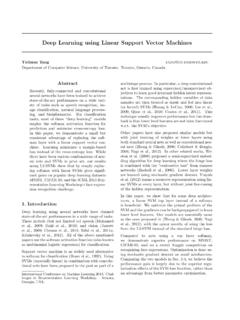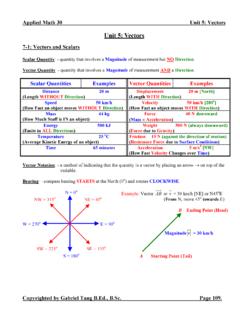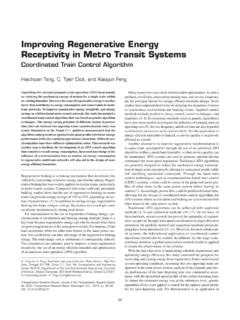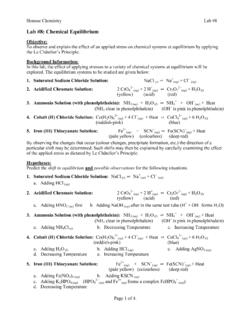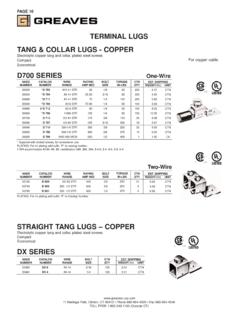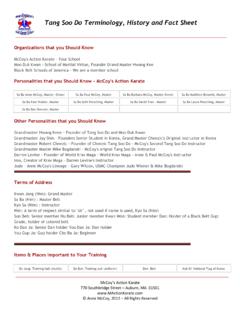Transcription of Monitoring and modeling dissolved oxygen dynamics through ...
1 Monitoring and modeling dissolved oxygen dynamics throughcontinuous longitudinal sampling : a case study in Wen-RuiTang River, Wenzhou, ChinaJun Li,1,2 Huixia Liu,1 Yancheng Li,1 Kun Mei,1 Randy Dahlgren1,2and Minghua Zhang1,2*1 Wenzhou Medical College, Zhejiang, China2 Dept. of Land, Air and Water Resources, University of California Davis, CA, USAA bstract:Synoptic water sampling at afixed site Monitoring station provides only limited snap-shots of the complex water qualitydynamics within a surface water system. However, water quality often changes rapidly in both spatial and temporal dimensions,especially in highly polluted urban rivers. In this study, we designed and applied a continuous longitudinal sampling technique tomonitor thefine-scale spatial changes of water quality conditions, assess water pollutant sources, and determine the assimilativecapacity for biochemical oxygen demand (BOD) in an urban segment of the hypoxic Wen-Rui tang River in eastern China.
2 Thecontinuous longitudinal sampling was capable of collecting dissolved oxygen (DO) data every 5 s yielding a ~11 m samplinginterval with a precision of mg L 1. The Streeter and Phelps BOD-DO model was used to calculate: (1) the oxygenconsumption coefficient (K1) required for calibration of water quality models, (2) BOD assimilative capacity, and (3) BODsource and load identification. In the 2014 m river segment sampled, the oxygen consumption coefficient (K1) was d 1(20 C), the total BOD discharge was 916 kg d 1, and the BOD assimilative capacity was 382 kg d 1when the minimum DOlevel was set to 2 mg L 1. In addition, the longitudinal analysis identified eight major drainage outlets (BOD point sources),which were verified byfield observations.
3 This new approach provides a simple, cost-effective method of evaluating BOD-DOdynamics over large spatial areas with rapidly changing water quality conditions, such as urban environments. It represents amajor breakthrough in the development and application of water quality sampling techniques to obtain spatially distributed DOand BOD in real time. Copyright 2012 John Wiley & Sons, WORDS water quality Monitoring ; oxygen consumption coefficient; dissolved oxygen ; hypoxia; Streeter and Phelps model;assimilative capacityReceived 29 November 2011; Accepted 19 June 2012 INTRODUCTIONC hina currently faces severe urban water quality fact that 90% of urban waterways are classified asheavily polluted (SEPA-China, 2005) has raised greatconcerns about human and aquatic ecosystem health (Zhanget al.)
4 , 2010; Voss, 2011). Monitoring water quality is thefirst step toward understanding the characteristics of waterpollution and for devising effective mitigation synoptic sampling at afixed Monitoring stationprovides only a snap-shot understanding of the complexspatial-temporal water quality dynamics occurring within asurface water system. This complexity is especiallypronounced in river systems spanning urban and agricul-tural land uses where numerous point and non-point inputsoccur over relatively short distances. Thus, the singleconstant assimilative capacity coefficient (self-purificationcoefficient) obtained from such sampling does not accur-ately portray the biochemical oxygen demand-dissolvedoxygen (BOD-DO) dynamics for large surface watersystems crossing urban and agricultural boundaries.
5 In fact,direct quantification of the assimilative capacity of rivers isvery difficult to measure (Taseet al., 1993).As early as 1925, scientists have modeled BOD-DOdynamics in polluted surface waters. Streeter and Phelps(1925) proposed the well-known Streeter Phelps (SPmodel) oxygen Sag Formula to describe the oxygenbalance in streams. Throughout the years, researchersfurther improved and applied these equations to variousscenarios (Theriault, 1927; Fair, 1939; Thomas, 1948; Li,1962, 1972; Camp, 1963; Beck and Young, 1976;Gundelach and Castillo, 1976; Thomann and M ller,1987; Yuet al., 1991; Adrianet al., 1994; Jolankai,1997). Despite the emergence of many complex waterquality models ( QUAL2E, Brown and Barnwell, 1987;WASP6, Woolet al.)
6 , 2001) describing DO dynamicsresulting from changes of BOD, the SP model and itsmodifications,still remain among those most widely used(Gotovtsev, 2010). In the SP model, the oxygen consump-tion coefficient (K1) represents the rate of O2consumptiondue to oxidation of organic matter and other reducedsubstances ( NH4+,Fe2+,S2-). The reaeration coefficient(K2) represents the rate of O2input to the river and isinfluence byflow rate, water depth, turbulence (mixing),water temperature, and degree of water column oxygen *Correspondence to: Minghua Zhang, Department of Land, Air and WaterResources, University of California Davis, One Shields Ave., Davis, CA95616, : PROCESSESH ydrol. Process.(2012)Published online in Wiley Online Library( ) DOI: 2012 John Wiley & Sons, There are other methods for calculating thesecoefficients, such as the empirical formula used to calculateK2in the EPD-RIV1 water quality model (Martin and Wool,2002).
7 The oxygen consumption coefficient (K1)isanimportant parameter for current riverine water qualitymodels, such as EPD-RIV1 and QUAL2K (Chapra andPelletier, 2003). The accuracy of water quality predictions iscritically dependent on the selectedK1value as it is theprimary driver describing oxygen consumption , it is not possible to determineK1from synopticwater quality sampling alone. While BOD kinetics can bedetermined in the laboratory, such procedures requiresubstantial resources, and laboratory measures cannotaccount for the complexities of oxygen consumptionoccurring in the real-world river setting ( sedimentoxygen demand and diel cycles).The Wen-Rui tang River located in Wenzhou,Zhejiang province, is one of the most polluted rivers inChina with many portions of the 1178 km of urbanwaterways being dead zones due to persistent pollution problem is compounded by the very lowgradient and diversion of upstream waters, which result inlittle or noflow toflush the pollutants from the urbanriver system during dry periods.
8 Because of their spatialcomplexity, synoptic sampling may not accurately depictthe distribution of the pollutantssources in this system,confounding proper management decisions. This riverremains highly polluted despite a substantial investmentby the local government in recent years to clean it better inform future policy and managementdecisions, the objective of this study was to monitor therapid spatial changes of water quality using continuouslongitudinal water quality Monitoring technology and tomodel BOD-DO dynamics . These data are then used toidentify the hidden drainage outlets from whichpollutantsflow into the river, and to estimate the oxygenconsumption coefficient to spatially evaluate the pollutantloads along the course of the river.
9 These can bedetermined by the difference analysis of the SP modeland its related parameters. In contrast to BOD valuesdetermined in the lab, continuous longitudinal monitoringfor DO is easily achieved and inexpensive using currentwater quality sensor technology. Thus, the specific focusof this study was to calculate the spatial variability inoxygen consumption (K1) and reaeration (K2) coefficientsusing temperature, DO, and GPS coordinates derivedfrom the continuous longitudinal Monitoring . The mod-eling results also allow for quantification of the BODassimilative capacity and BOD source and load identifi-cation. The results of this study provide importantinformation to guide water quality modeling , BOD sourceidentification, and numerical targets for BOD loadreductions to meet water quality AND METHODSThe study siteThe Wen-Rui tang River watershed is located inWenzhou City, Zhejiang, China (Figure 1).
10 The watershedhas an area of 740 km2with a population of about and land-use distribution consisting of urban, agriculture, wetlands, 38% hilly forest, others. The main stem of the Wen-Rui tang RiverFigure 1. Map of Hualongqiao River, showing location of study site. Hualongqiao River is one branch of Wen-Rui tang River in Wenzhou, China. TheCoordinates of the river center is (27 59 "N, 120 40 "E)J. LIET 2012 John Wiley & Sons, Process.(2012)spans km in the urban area andflows through a networkof interconnecting urban waterways with a total length of1178 km. The width of the urban portion of the Wen-RuiTang River is about 50 m on average, varying from about13 to 150 m. Due to direct discharge of large amounts ofdomestic, industrial, and agricultural wastewater into theriver, the water quality of the river is severely impaired,particularly since the rapid economic development of the1980s.
